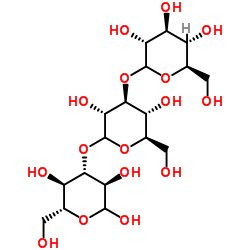Laminaran

Laminaran structure
|
Common Name | Laminaran | ||
|---|---|---|---|---|
| CAS Number | 9008-22-4 | Molecular Weight | 504.437 | |
| Density | 1.8±0.1 g/cm3 | Boiling Point | 902.8±65.0 °C at 760 mmHg | |
| Molecular Formula | C18H32O16 | Melting Point | N/A | |
| MSDS | Chinese USA | Flash Point | 499.8±34.3 °C | |
|
Functional characterization of polysaccharide utilization loci in the marine Bacteroidetes 'Gramella forsetii' KT0803.
ISME J. 8(7) , 1492-502, (2014) Members of the phylum Bacteroidetes are abundant in many marine ecosystems and are known to have a pivotal role in the mineralization of complex organic substrates such as polysaccharides and proteins. We studied the decomposition of the algal glycans laminar... |
|
|
The proteome response of potato leaves to priming agents and S-nitrosoglutathione.
Plant Sci. 198 , 83-90, (2013) The primed mobilization for more potent defense responses to subsequent stress has been shown for many plant species, but there is a growing need to identify reliable molecular markers for this unique phenomenon. In the present study a proteomic approach was ... |
|
|
Effects of supplementing dietary laminarin and fucoidan on intestinal morphology and the immune gene expression in the weaned pig.
J. Anim. Sci. 90 Suppl 4 , 284-6, (2012) Previous studies have shown the benefit of combining seaweed extracts laminarin (LAM) and fucoidan (FUC) on improving growth in piglets' performance after weaning. A 2 × 2 factorial experiment was conducted to investigate the interaction between FUC (0 and 24... |
|
|
The effect of seaweed extract as an alternative to zinc oxide diets on growth performance, nutrient digestibility, and fecal score of weaned piglets.
J. Anim. Sci. 90 Suppl 4 , 224-6, (2012) This study investigated if supplementing the diet with seaweed extracts (SWE) containing laminarin and fucoidan would promote growth performance, nutrient digestibility, and fecal consistency in newly weaned piglets during 2 growth phases as compared with ZnO... |
|
|
Effect of supplementing different ratios of laminarin and fucoidan in the diet of the weanling piglet on performance, nutrient digestibility, and fecal scoring.
J. Anim. Sci. 90 Suppl 4 , 215-7, (2012) A 3 × 2 factorial experiment was conducted to investigate the effects of different ratios of dietary laminarin (LAM) and fucoidan (FUC) on growth performance and nutrient digestibility in newly weaned piglets. At weaning, 168 piglets (24 d of age; 6.8 kg live... |
|
|
Lipopolysaccharide and β-1,3-glucan-binding protein (LGBP) bind to seaweed polysaccharides and activate the prophenoloxidase system in white shrimp Litopenaeus vannamei.
Dev. Comp. Immunol. 55 , 144-51, (2015) Lipopolysaccharide and β-1,3-glucan-binding protein (LGBP), important pattern recognition proteins (PRPs), recognize lipopolysaccharide (LPS) and β-1,3-glucan (βG), known as pathogen-associated molecular patterns (PAMPs), and subsequently trigger innate immun... |
|
|
Effect of seaweed-derived laminarin and fucoidan and zinc oxide on gut morphology, nutrient transporters, nutrient digestibility, growth performance and selected microbial populations in weaned pigs.
Br. J. Nutr. 111(9) , 1577-85, (2014) In the present study, two experiments were conducted to (1) evaluate the effect of laminarin and/or fucoidan on ileal morphology, nutrient transporter gene expression and coefficient of total tract apparent digestibility (CTTAD) of nutrients and (2) determine... |
|
|
Nitric oxide-mediated stress imprint in potato as an effect of exposure to a priming agent.
Mol. Plant Microbe Interact. 25(11) , 1469-77, (2012) We investigated how potato exposed to a chemical agent could activate nitric oxide (NO)-dependent events facilitating more potent defense responses to a subsequent pathogen attack. Obtained data revealed that all applied inducers, i.e., β-aminobutyric acid (B... |
|
|
The N-terminal domain of Drosophila Gram-negative binding protein 3 (GNBP3) defines a novel family of fungal pattern recognition receptors.
J. Biol. Chem. 284(42) , 28687-97, (2009) Gram-negative binding protein 3 (GNBP3), a pattern recognition receptor that circulates in the hemolymph of Drosophila, is responsible for sensing fungal infection and triggering Toll pathway activation. Here, we report that GNBP3 N-terminal domain binds to f... |
|
|
Increased Levels of Antinutritional and/or Defense Proteins Reduced the Protein Quality of a Disease-Resistant Soybean Cultivar.
Nutrients 7 , 6038-54, (2015) The biochemical and nutritional attributes of two soybean (Glycine max (L.) Merr.) cultivars, one susceptible (Seridó) and the other resistant (Seridó-RCH) to stem canker, were examined to assess whether the resistance to pathogens was related to levels of an... |